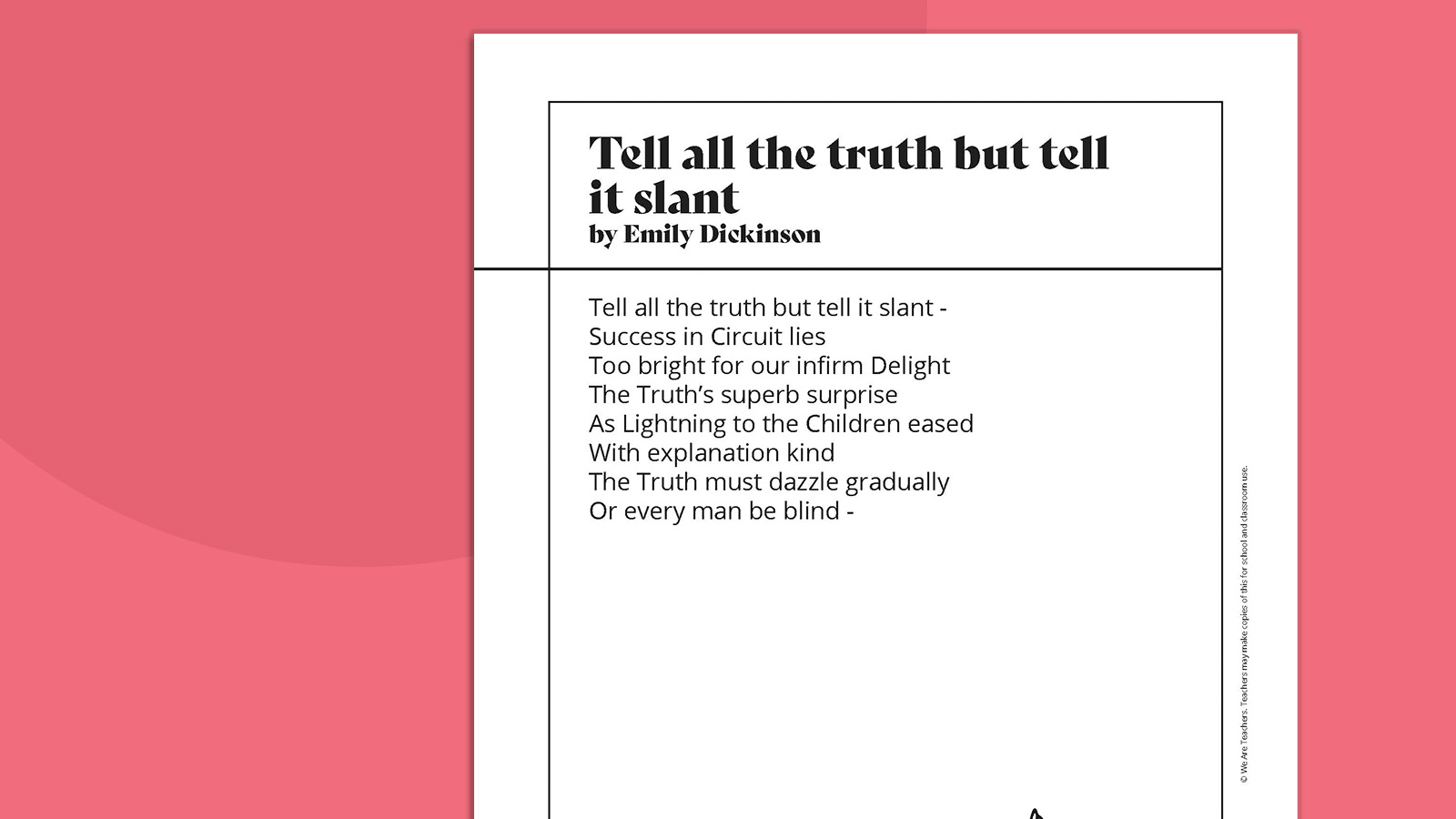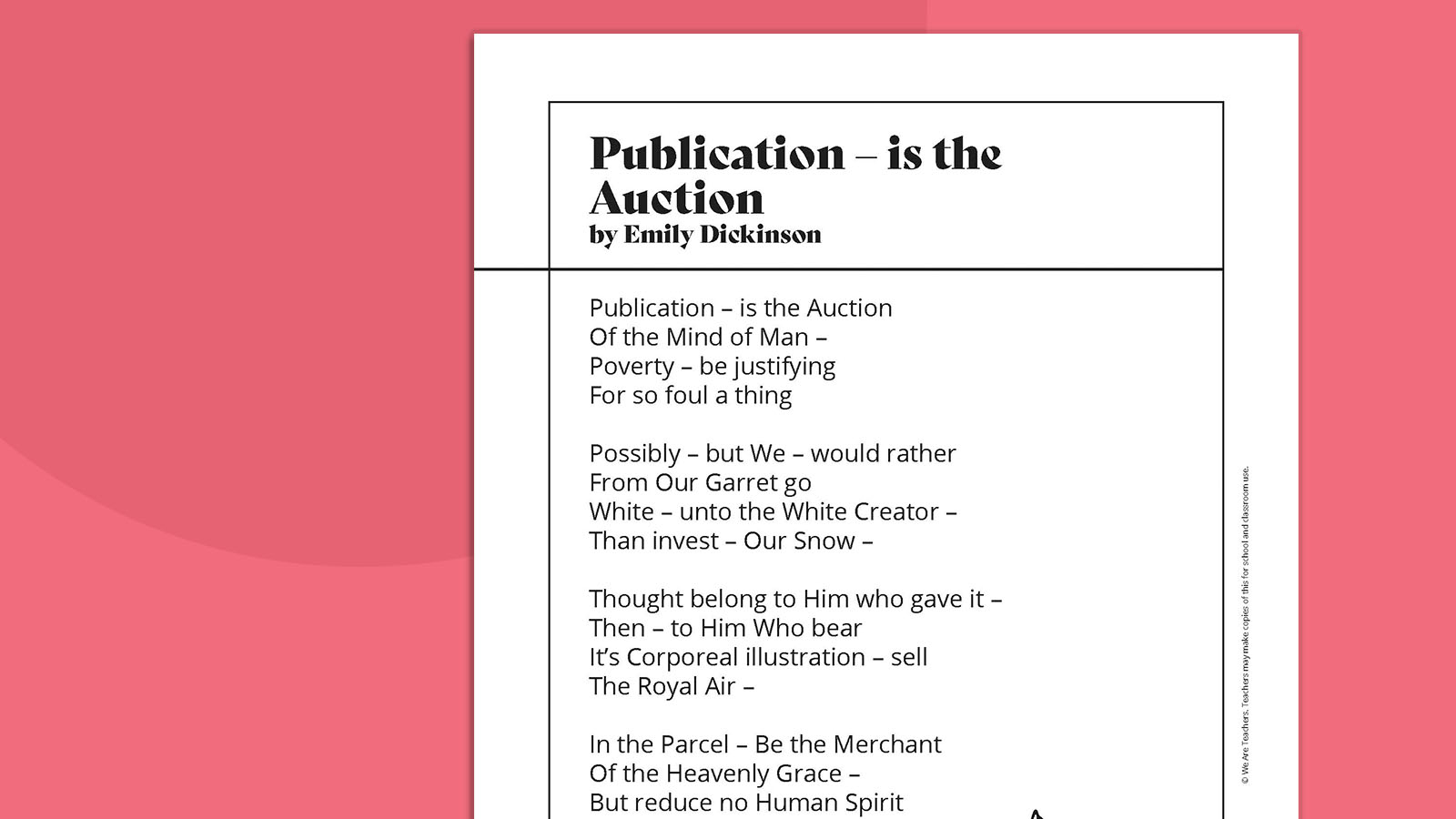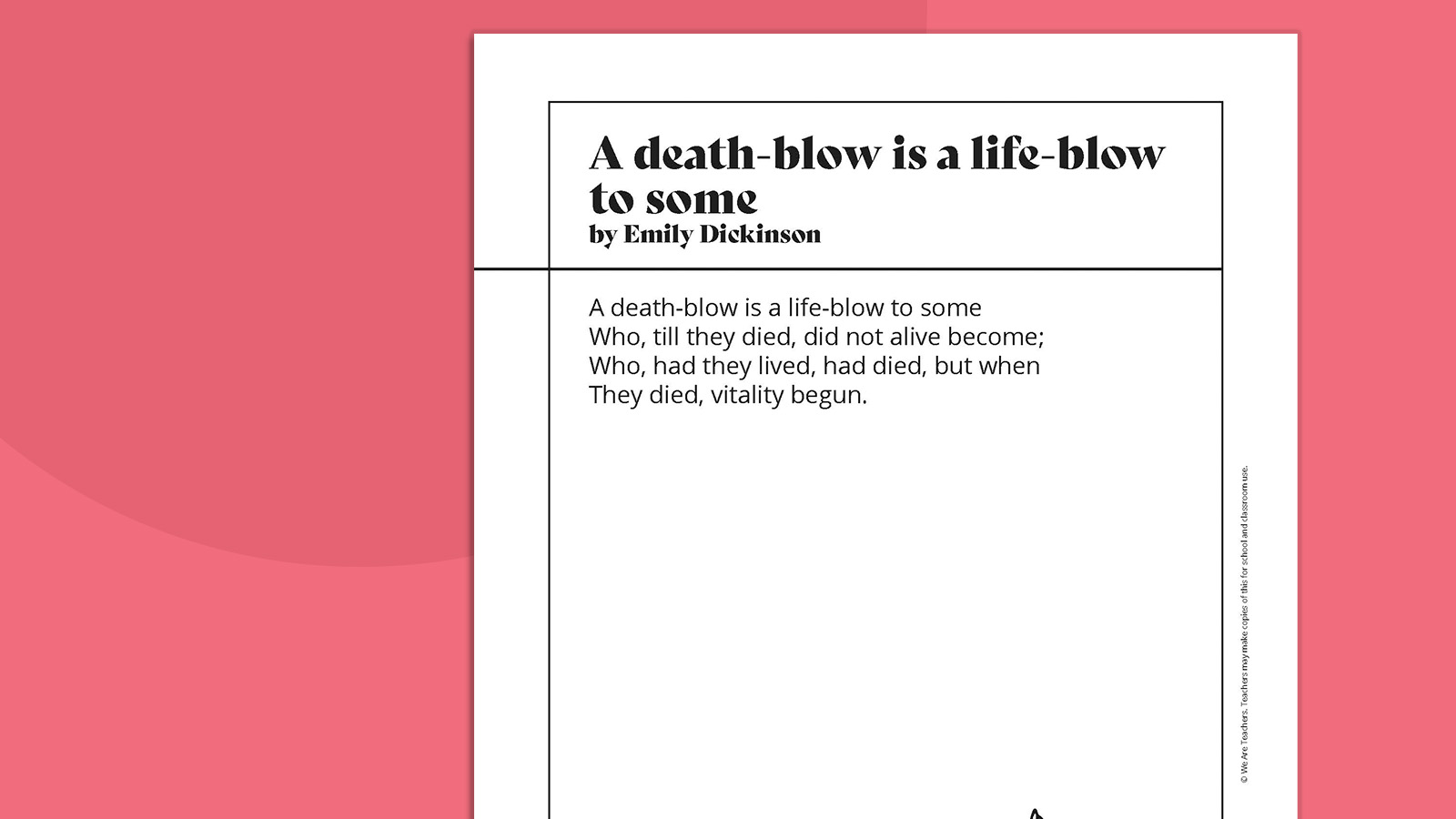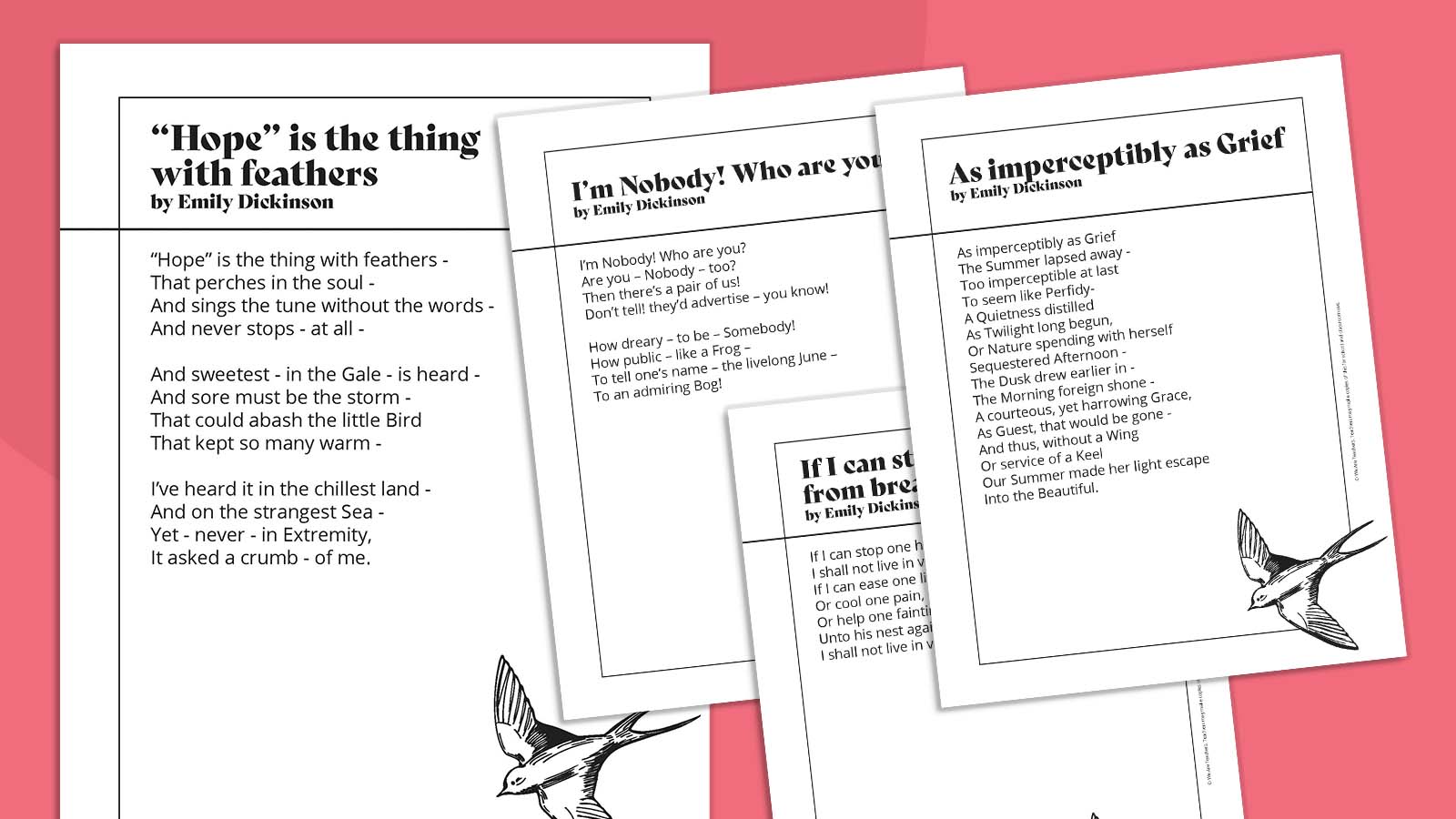Emily Dickinson remains one of the most mysterious poets. She didn’t leave an autobiography or journals, and she wrote many of her poems in secret. (After Emily Dickinson died, her sister found almost 1,800 poems in her bedroom.) So, without a lot of guidance from Dickinson about why she was writing or the meaning behind her poems, we have to read her poetry with an open mind. Perhaps that’s why her poetry is so profound—each reader brings themselves to her poems and connects with her words from where they are.
The 25 Emily Dickinson poems below are among her most popular. Get the full text of each poem as a free printable to use with your students by filling out the form on this page.
Jump to:
25 Famous Emily Dickinson Poems
Who was Emily Dickinson?

Emily Dickinson was born in 1830 to a wealthy Massachusetts family. She was known for her individuality and “rebellious” attitude. She wrote poems with themes of death, immorality, faith, fame, and doubt. Her poetry is known especially for her originality and style with unconventional capitalization and dashes to move the poem along. She’s still an incredibly popular American poet and a wonderful poet to read to get students interested in poetry in general.
These 25 Emily Dickinson poems are a drop in the bucket (she wrote almost 1,800 poems), but these are among the best and show her range, mastery of language, and innovation.
Get the full text of each poem as a free printable to use with your students by filling out the form on this page.
25 Famous Emily Dickinson Poems
“Hope” is the thing with feathers
“Hope” is the thing with feathers –
That perches in the soul –
And sings the tune without the words –
And never stops – at all –
This Emily Dickinson poem is among her most famous. It reads like a song (characteristic of Dickinson’s poetry). This is a good poem to start a unit on poetry as it’s life-affirming and, well, hopeful.
Success is counted sweetest
Success is counted sweetest
By those who ne’er succeed.
To comprehend a nectar
Requires sorest need.
Fame was a theme in Dickinson’s work. This particular poem was published anonymously in an anthology (Dickinson’s father did not think women should publish, and she published few poems during her lifetime). This poem begs the question, did Dickinson avoid fame because she wanted to protect her name or because she had already tried to seek fame and been rejected?
I felt a Funeral, in my Brain

I felt a Funeral, in my Brain,
And Mourners to and fro
Kept treading – treading – till it seemed
That Sense was breaking through –
Outside of the literary world, Dickinson is known for her poems on mental health. This poem is perhaps her most famous about mental health. After reading it, students can talk about what in Dickinson’s experience may have sparked this poem and what she wants to communicate about mental health.
I’m Nobody! Who are you?
I’m Nobody! Who are you?
Are you – Nobody – too?
Then there’s a pair of us!
Don’t tell! they’d advertise – you know!
Dickinson is known for her use of seemingly random capital letters. This poem is a great one to explore for why she capitalized some letters and how it influences the meaning of the poem. For example, when she capitalizes “nobody,” how does it change the meaning of the word?
Because I could not stop for Death
Because I could not stop for Death –
He kindly stopped for me –
The Carriage held but just Ourselves –
And Immortality.
This classic, melancholic poem is among the many Emily Dickinson poems that deal with death and the afterlife. Just the first two lines provide a lot to talk about. But the poem is not dark—on the contrary, it’s hopeful and meditative.
A Bird, came down the Walk
A Bird, came down the Walk –
He did not know I saw –
He bit an Angle Worm in halves
And ate the fellow, raw …
This poem is good for younger readers because it is an observation of nature, with details that children can understand.
My Life had stood – a Loaded Gun
My Life had stood – a Loaded Gun –
In Corners – till a Day
The Owner passed – identified –
And carried Me away –
This poem has one of Dickinson’s strongest first lines (and she has a lot of strong first lines!). The actual topic of the poem is up for debate—is it the afterlife or her meditation on anger? Or is it Dickinson’s frustration with having to write in secret?
Tell all the truth but tell it slant –

Tell all the truth but tell it slant –
Success in Circuit lies
Too bright for our infirm Delight
The Truth’s superb surprise …
In this more playful poem, Dickinson uses images to get the point across that one can be honest in a kind way. This poem is more didactic than other Emily Dickinson poems, which makes it interesting in its own right.
There’s a certain Slant of light
There’s a certain Slant of light,
Winter Afternoons –
That oppresses, like the Heft
Of Cathedral Tunes –
This poem is a serious contemplation of the seasons changing, time passing, and endings, from a year ending to the ultimate ending, death.
This is my letter to the World
This is my letter to the World
That never wrote to Me –
The simple News that Nature told –
With tender Majesty …
In this poem, Dickinson takes a stronger stance on communicating with her readers. It’s one of her poems where the feelings (loneliness, frustration) leap right off the page. Read this poem alongside composer David Leisner’s version that puts the words to song.
I dwell in Possibility –
I dwell in Possibility –
A fairer House than Prose –
More numerous of Windows –
Superior – for Doors –
This poem is a great one to connect to Dickinson’s life—she was a homebody. You can also read it for the use of imagery—the use of architectural references to create meaning in the poem, and the use of juxtaposition—the smallness of chambers against the expansive sky.
I heard a Fly buzz – when I died –
I heard a Fly buzz – when I died –
The Stillness in the Room
Was like the Stillness in the Air –
Between the Heaves of Storm –
This poem is in the canon of poems about death, but with a little more humor and matter-of-factness than other poems. Students can analyze this poem with a focus on deciding when description is literal and when it is meant to be figurative.
It was not Death, for I stood up
It was not Death, for I stood up,
And all the Dead, lie down –
It was not Night, for all the Bells
Put out their Tongues, for Noon.
This poem is an objective observation of Dickinson’s state and her feelings on pain and hopelessness. Students can analyze the way Dickinson describes these feelings, and how she uses opposites (“it was not …”) to help set the tone and meaning of the poem. Read this analysis for more insight.
Before I got my eye put out –

Before I got my eye put out –
I liked as well to see
As other creatures, that have eyes –
And know no other way –
Dickinson is known to have had bad eyesight and eyes that were light sensitive and sometimes painful. With that biographical information, it’s hard not to read this poem literally. Dickinson never had her eye put out, but we are reading the words of someone whose eyesight, or loss of eyesight, is a frustrating or even frightening topic.
After great pain, a formal feeling comes –
After great pain, a formal feeling comes –
The Nerves sit ceremonious, like Tombs –
The stiff Heart questions ‘was it He, that bore,’
And ‘Yesterday, or Centuries before’?
This poem is only 13 lines long, but it hits the emotional level that makes Dickinson unique. It’s about the numb feelings that come after strong emotions, like grief, and how short those feelings can be.
Dear March – Come in –
Dear March, how are you, and the Rest –
Did you leave Nature well –
Oh March, Come right upstairs with me –
I have so much to tell –
This poem is about the coming of spring and is written as a letter between the poet and a guest, the month of March personified. It’s a good counterpoint to “There’s a certain Slant of light,” showing how Dickinson thought about various times in the year and periods of life.
My life closed twice before its close
My life closed twice before its close –
It yet remains to see
If Immortality unveil
A third event to me
This poem provides a metaphor for death. “Close” shows both heartbreak and death, and Dickinson ends the poem with a note of sarcasm. This is a poem for which we’d love to know more about Dickinson’s personal life to understand.
To fight aloud is very brave
To fight aloud, is very brave –
But gallanter, I know
Who charge within the bosom
The Cavalry of Wo –
This poem explores the honor in living and dying quietly. It recognizes that there is honor in fighting and dying with valor, but also in the unsung or quieter lives and fights.
Publication—is the Auction

Publication – is the Auction
Of the Mind of Man –
Poverty – be justifying
For so foul a thing …
One of the questions about Dickinson is whether she wanted to be published at all. Much of her work was published after her death, and her poems convey that she may not have wanted fame or even publication. In today’s world of constant content creation, this poem is a great way to start a conversation about what’s worth sharing and when we might create just for the joy of it.
If I can stop one heart from breaking
If I can stop one heart from breaking,
I shall not live in vain;
If I can ease one life the aching,
Or cool one pain,
Or help one fainting robin
Unto his nest again,
I shall not live in vain.
This is another famous Dickinson poem. The theme of wanting to make life worth living is another great one for middle and high schoolers who are starting to think about philosophical ideas.
The Heart asks Pleasure – first
The Heart asks Pleasure – first –
And then – Excuse from Pain –
And then – those little Anodynes
That deaden suffering –
Another poem that is a meditation on what life is and what makes it meaningful. Students can analyze what Dickinson sees as important: pleasure, lack of pain, comfort.
I died for Beauty – but was scarce
I died for Beauty – but was scarce
Adjusted in the Tomb
When One who died for Truth, was lain
In an adjoining Room –
One of the most well-known poems about death by Dickinson and one of the most lyrical, this poem is also about the meaning of life and what might come after death. Two dead people meet, each having lived and died for a different reason. In the end, we see that both got covered up, leaving the question of which is more important in the long-term.
As imperceptibly as Grief
As imperceptibly as Grief
The Summer lapsed away –
Too imperceptible at last
To seem like Perfidy –
Grief is often a theme in Dickinson’s poetry, and this poem tackles that theme head-on. In this poem, the rhythms of nature and details of the natural world are in parallel with human actions as summer ends.
A death-blow is a life-blow to some

A death-blow is a life-blow to some
Who, till they died, did not alive become;
Who, had they lived, had died, but when
They died, vitality begun.
This short and sweet poem packs a punch. It’s all about people who are more impactful in death than in life (not unlike Dickinson’s own life). Students can analyze these four lines and connect them to other poems about death and fame, or to Dickinson’s biography.
I have not told my garden yet
I have not told my garden yet,
Lest that should conquer me;
I have not quite the strength now
To break it to the bee.
This poem is a perfect example of Dickinson’s tone, imagery, and understated prose. It’s a great poem to introduce or conclude a unit on Dickinson.
Now that students are intrigued, here are 24 famous poets students should know.
Get free printables of all of these Emily Dickinson poems.
Share your email address for instant access to full-text printable versions of all the Emily Dickinson poems on this list.

